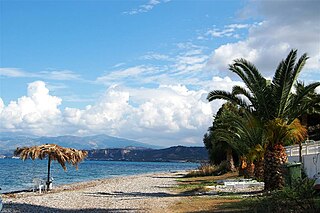Related Research Articles

Alissos is a village and a community in the municipal unit of Dymi, Achaea, Greece. It is located near the Gulf of Patras, 3 km east of Kato Achaia, 3 km southwest of Kaminia and 17 km southwest of Patras. The community consists of the villages Alissos, Kamenitsa, Paralia Alissou and Profitis Elissaios. The Greek National Road 9 and the railway from Patras to Pyrgos run between Alissos and Paralia Alissou.
Villehardouin was a noble dynasty originating in Villehardouin, a former commune of the Aube department, now part of Val-d'Auzon, France. It is most notable as the ruling house of the Principality of Achaea, a Frankish crusader state in the Peloponnese peninsula of Greece, between 1209 and 1278, when possession passed to the angevin Kings of Naples.
Centurione I Zaccaria (1336–1376) was a powerful noble in the Principality of Achaea in Frankish Greece. In 1345 he succeeded his father, Martino Zaccaria, as baron of Damala and lord of one half of the Barony of Chalandritsa, and in 1359 he acquired the other half. In about 1370 he was named Grand Constable of Achaea and received also the Barony of Estamira. He also thrice held the post of bailli (viceroy) for the principality's Angevin rulers.
John Chauderon was the Baron of Estamira and Grand Constable of the Principality of Achaea, the strongest of the principalities of Frankish Greece.

The Barony of Passavant or Passava was a medieval Frankish fiefdom of the Principality of Achaea, located in the mountains between the Mani peninsula and the plain of Laconia, in the Peloponnese peninsula in Greece, centred on the fortress of Passavant or Passava. It was among the twelve original baronies of the Principality of Achaea, but was conquered by the Byzantines in the early 1260s.

The Barony of Kalavryta was a medieval Frankish fiefdom of the Principality of Achaea, located in the Peloponnese peninsula in Greece, centred on the town of Kalavryta.

The Barony of Karytaina or of Skorta was a medieval Frankish fiefdom of the Principality of Achaea, located in the Peloponnese peninsula in Greece, centred on the town of Karytaina in the mountainous region known as Skorta.

The Barony of Arcadia was a medieval Frankish fiefdom of the Principality of Achaea, located on the western coast of the Peloponnese peninsula in Greece, and centred on the town of Arcadia, ancient and modern Kyparissia.
Vilain of Aulnay was a French knight from Aulnay-l'Aître in the Champagne who became marshal of the Latin Empire of Constantinople and first Baron of Arcadia in the Principality of Achaea. In the Greek version of the Chronicle of the Morea, he is attested as Βηλὲς ντὲ Ἀνόε, a form which passed to the other versions of the Chronicle as Anoé, Annoée or Anoée.
Geoffrey of Briel, in older literature Geoffrey of Bruyères, was a French knight and the third lord of the Barony of Karytaina in the Principality of Achaea, in Frankish Greece. He led a colourful and turbulent life, narrated in detail in the Chronicle of the Morea. Accounted the finest knight in the Principality, he fought in the wars against the Byzantine Greeks, was captured in the Battle of Pelagonia in 1259, and was sent back to Achaea bearing the Byzantine terms in 1261. Geoffrey was twice deprived of his barony, once for rebelling against his uncle, the Prince of Achaea William II of Villehardouin, and then for abandoning the Principality without leave in order to spend time with a mistress, the wife of one of his feudatories, in Italy. He was pardoned both times, but henceforth held his title as a gift of the Prince. He died childless in 1275, and the Barony of Karytaina was split up.
Andronikos Asen Zaccaria or Asanes Zaccaria was a Genoese lord of the Principality of Achaea in southern Greece.
Nicholas le Maure was a French knight of the Principality of Achaea, lord of Saint-Sauveur, who served as the Principality's bailli on behalf of the Angevins of Naples between 1314 and 1315/6.

The Battle of Picotin was fought on 22 February 1316 between the Catalan forces of the infante Ferdinand of Majorca, claimant to the Principality of Achaea, and the forces loyal to Princess Matilda of Hainaut, comprising native levies from the barons loyal to the Princess as well as Burgundian knights. The battle ended in a crushing victory for Ferdinand, but he was later engaged and killed by the troops of Matilda's husband, Louis of Burgundy, at the Battle of Manolada.
Peter dalle Carceri was a Triarch of Euboea and Baron of Arcadia. He was son of Grapozzo dalle Carceri and Beatrice of Verona, both Lords of Euboea.
Geoffrey II of Briel or Geoffrey of Briel the Younger, was a French knight and the cousin or nephew of Geoffrey I of Briel, Baron of Karytaina in the Principality of Achaea, in Frankish Greece.
John of Nully was a French knight from Nully became the first Baron of Passavant in the Principality of Achaea. The date of his death is unknown.

The Battle of Saint George took place on 9 September 1320 between the Latin Principality of Achaea and the forces of the Byzantine governor of Mystras, at the fortress of Saint George in Skorta in Arcadia. As a result of the battle, Arcadia, the heartland of the Morea, came firmly under Byzantine control.
Erard III Le Maure was Baron of Arcadia and Marshal of the Principality of Achaea in the mid-14th century.
Erard I of Aulnay was lord of one half of the Barony of Arcadia in the Principality of Achaea.
Geoffrey of Aulnay was Baron of Arcadia in the Principality of Achaea in the late 13th century.




